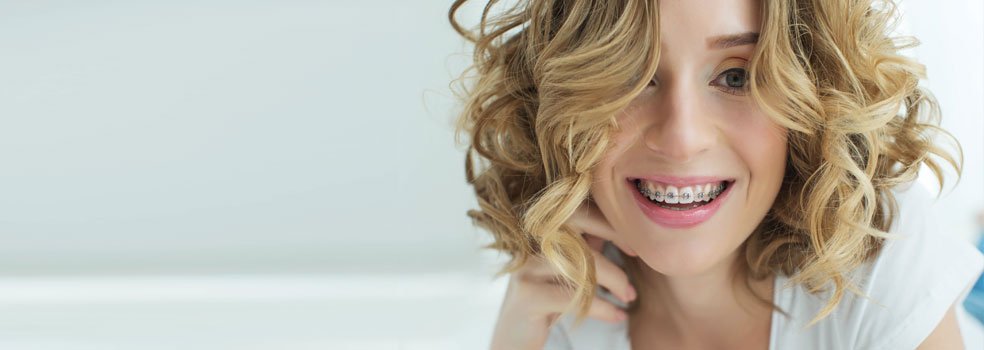Have you caught yourself staring at models in magazines and wishing for a smile as perfect as theirs? Getting a beautiful smile can be as easy as 1 2 3! With braces, you can transform your smile into whatever you want it to be. At one of North Yorkshire’s finest orthodontic practices, we can bring a stunning smile from your dreams and make it your own in real life!
What are fixed braces?
For more than a century, braces have helped to achieve straight teeth and a symmetrical smile. Now, traditional braces are no more just wires and chunks of metal. In today’s orthodontics, braces are lighter than ever and have steadily advanced to create your desired smile.
Braces are dental devices which help correctly align and straighten your teeth and get rid of common problems such as misaligned teeth, crowded teeth, and crooked teeth. Braces work by gradually applying forces on your teeth to bring them into a normal bite.
Fixed braces are made up of three parts:
- Bands: They are anchored around the teeth to hold the brackets and wires.
- Brackets: Brackets are most often bonded to the front of the teeth using special dental cement. These brackets can be metal, ceramic, plastic, or a combination of all.
- Archwires: Wires are passed through the brackets and attached to the bands. Tightening this archwire can put pressure on the teeth and gradually move them to their desired positions.
What can braces fix?
Conventional braces offer great results for a number of dental issues, some of which are highly complex.
- Overcrowded teeth: When there is a discrepancy between the size of your teeth and jaws. Overcrowded teeth can be unsightly and cause many hygiene problems.
- Uneven gaps: When there is a discrepancy between the size of your teeth and jaws or when missing teeth.
- Prominent front teeth: Also known as an increased overjet, can occur due to the position of the jaws or angulation of the teeth.
- Crossbites: When the upper and lower jaws are both maligned.
- Overbites: When upper teeth overlap significantly with the lower teeth.
- Underbites: Also known as reverse overjets, can occur when the lower teeth protrude past the front teeth.
- Impacted teeth – in some patients, secondary teeth come through in the wrong position or do not erupt at all.
Braces procedure: How are they done?
Each brace treatment plan is tailored to fit the patient’s needs. Here at Windmill Orthodontics York, we make sure that each patient receives a treatment plan that is personalised and unique to best suit them and their oral health.
Through these simple steps, your Orthodontist will be able to place your braces and have them adjusted at regular timings to ensure proper and adequate movement of the teeth.
- Prior to the placement of braces, a cheek retractor is used to keep the teeth visible and dry throughout the procedure.
- The teeth are polished to ensure that the brackets adhere properly. The teeth are then air-dried.
- A conditioner is applied on the front surfaces of the teeth for 30 seconds to prepare them for bonding the brackets. It is then cleaned off, teeth are dried, and an adhesive primer is placed on the teeth.
- Cement is placed on the back of the brackets and then applied to the predetermined positions on the teeth.
- Once the brackets are placed on the teeth, they are set into place using a high-intensity light.
- The archwires are then placed and the process is completed in 30 to 50 minutes.
How long do you need to wear braces for?
The length of treatment differs per patient but on average it can take between 9 months to 2 years to complete depending on complexity.
Adjustments
Once your braces are in place, it is mandatory for you to attend regular adjustment appointments. This is because the elastic ties that hold the wires in place can stretch and weaken over time. With regular adjustments, you are ensuring that your teeth are always subjected to the proper pressure needed to correct your dental issues. These appointments can occur every six to eight weeks.
Retention
Braces help straighten your teeth to perfectly fit in your mouth. However, much to your surprise, your teeth will also have to learn to maintain their newly appointed positions. This is where retainers come in. A retainer is a dental appliance that can be a fixed wire on the back of your teeth or removable, much like your regular mouthguard. After your braces are removed, a retainer helps maintain the alignment and corrections made to your teeth. Without a retainer, your teeth will naturally relapse to some degree. How much is varies between people.
What is it like to have wear braces?
Most braces are made of metal or, more aesthetic, white ceramic. Although braces are designed to be comfortable in your mouth, they may rub the insides of your mouth and make it feel sore. Also, as your teeth begin to move, your teeth may feel tender and the braces may feel large in your mouth. However, these are only temporary inconveniences and usually subside on their own as you get used to having your braces in. You must remember to take good care of your braces and be careful of what you eat and drink.
Are the effects of braces permanent?
Braces help move your teeth to a stable position. You should wear your braces for as long as your Orthodontist advises you to. You will also need to religiously wear a retainer after your treatment has finished in order to stop your teeth from relapsing. We wouldn’t want all the hard work to go to waste!
How should I take care of my braces?
With braces comes responsibilities. It is important that you follow proper care protocols for your braces to help your teeth stay where to are and ought to be. Here are some do’s and don’ts to remember when caring for your braces.
- Avoid sticky food like toffee or caramel
- Ask for a mouthguard in case you play sports
- Avoid hard foods like walnuts or boiled sweets
- Brush your teeth after every meal to cleanse the food stuck on your braces
- Consume foods and drinks that are low on sugar content
- Limit your consumption of carbonated beverages
- Visit your dentist regularly for routine check-ups
- Brush your teeth using a fluoridated toothpaste
- Use a mouthwash for added protection
How successful are braces?
In most cases, orthodontic treatment works great but you need to stick with it for it to be successful. It depends on how well you take care of your braces and oral hygiene that your teeth stay aligned. Good oral hygiene and regular retainer wear are the keys to a straight smile.
When is the right time to get braces?
Every individual is different. Orthodontic treatment can be started as young as 7 years. There is no upper limit to age for braces. Just make sure that you have good oral health and firm teeth to be eligible for braces.
Braces can not only help straighten your teeth but can also elevate your confidence and self-esteem. If you have been battling with crooked teeth or crowded teeth, braces could be your answer. We are helping straighten York city’s smiles, one at a time. Will you be our next perfect smile?
Contact us for more details and to book a consultation.

